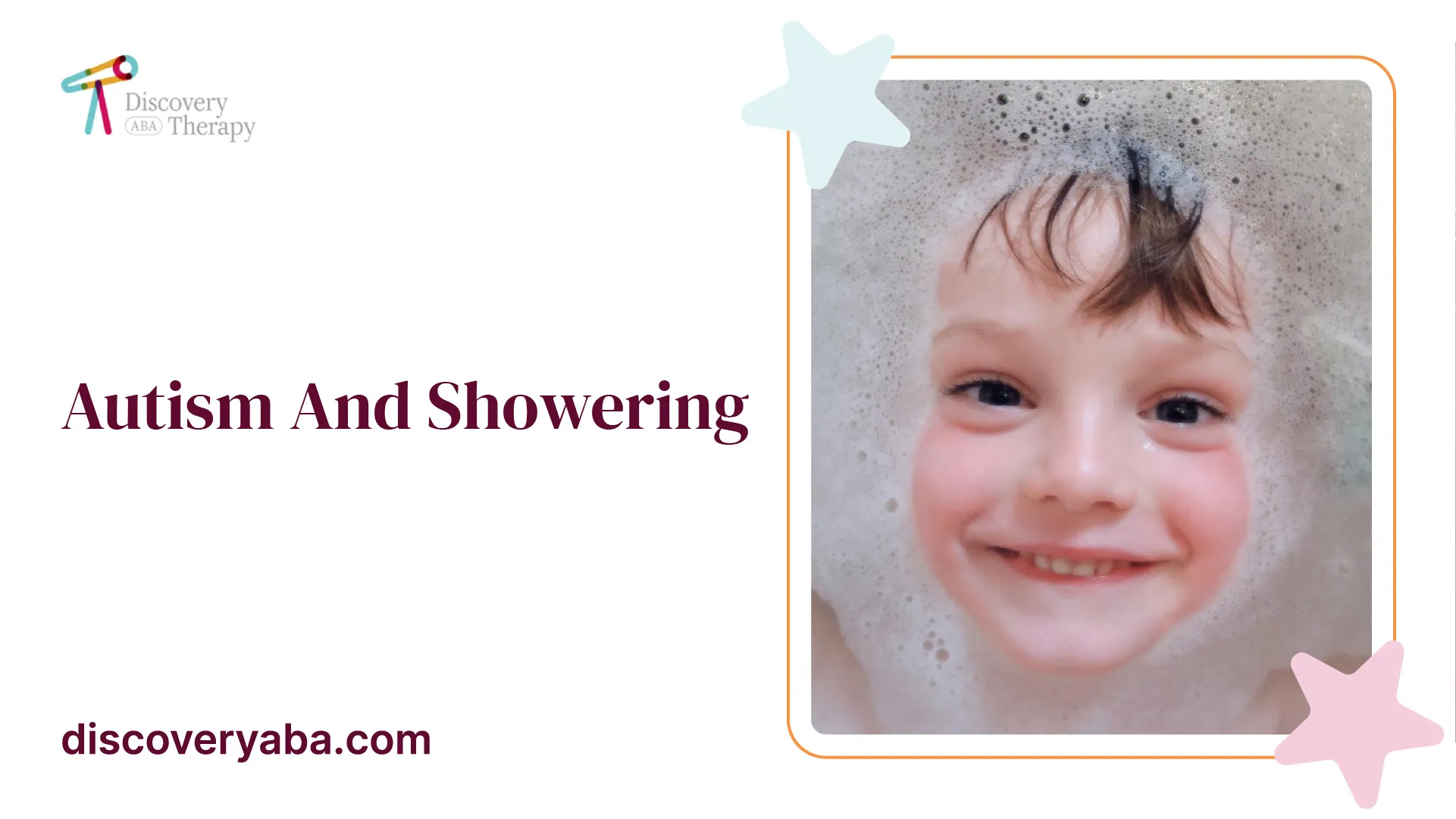Autism And Showering
Explore the human side of autism and showering. Gain insights into the unique sensory experiences individuals may have.
.jpeg)
Understanding Autism and Showering Difficulties
To effectively manage showering difficulties in individuals with autism, it is crucial to have a comprehensive understanding of autism itself and the specific challenges that may arise during showering routines.
What is Autism?
Autism, or Autism Spectrum Disorder (ASD), is a neurodevelopmental disorder that affects communication, social interaction, and behavior. It is characterized by a range of symptoms and can vary greatly in severity. Individuals with autism often have unique sensory sensitivities and may struggle with changes in routine or unfamiliar environments.

Common Challenges with Showering for Individuals with Autism
Showering can present specific challenges for individuals with autism. These challenges may arise due to sensory sensitivities, difficulties with transitions, or anxiety related to the showering process. Some common difficulties experienced by individuals with autism during showering include:
- Sensory sensitivities: Many individuals with autism have heightened sensory sensitivities. This means that the sensations of water, temperature changes, or the sound of running water may be overwhelming or uncomfortable for them.
- Transitions and changes in routine: Individuals with autism often thrive on routines and predictability. The transition from dry clothing to wet skin, or from one activity to another, can be challenging and cause anxiety or resistance.
- Fear or anxiety: The showering process may elicit fear or anxiety in individuals with autism. This could be due to a fear of water, a fear of slipping or falling, or a fear of the unknown. Understanding and addressing these fears is essential for a successful showering routine.
- Difficulty with self-care tasks: Some individuals with autism may struggle with the sequence of steps involved in showering, such as washing specific body parts or using appropriate amounts of soap and shampoo.
By recognizing these common challenges, caregivers and individuals with autism can work together to develop strategies and approaches that promote a positive and comfortable showering experience.
Understanding the unique needs and difficulties faced by individuals with autism is crucial when developing strategies to address showering difficulties. In the following sections, we will explore various approaches and techniques that can help individuals with autism overcome these challenges and develop a positive relationship with showering and personal hygiene.
Sensory Considerations
Individuals with autism may experience sensory sensitivities and preferences that can make showering a challenging task. Understanding and addressing these sensory considerations is crucial in creating a comfortable and enjoyable showering experience. In this section, we will explore sensory sensitivities and preferences, as well as strategies for creating a calming environment.
Sensory Sensitivities and Preferences
Autistic individuals may have heightened sensory sensitivities or differences in sensory processing. The showering experience can be overwhelming due to various sensory stimuli, such as water pressure, temperature, sound, and texture of bathing products. Some individuals may be hypersensitive, finding certain sensations uncomfortable or distressing, while others may be hyposensitive, seeking additional sensory input.
Understanding an individual's sensory sensitivities and preferences is essential in adapting the showering routine to their specific needs. This can involve observing and noting their reactions to different sensory stimuli during showering. For example, if an individual is sensitive to water temperature, adjusting the water temperature to their preference can help create a more comfortable experience.
Creating a Calming Environment
Creating a calming environment in the bathroom can significantly contribute to managing showering difficulties for individuals with autism. Here are some strategies to consider:
- Lighting: Soft, dimmable lighting or using natural light can help create a soothing atmosphere. Harsh or flickering lights may be distressing for some individuals with autism.
- Visual Supports: Visual supports, such as visual schedules and timers, can provide predictability and structure to the showering routine. These supports can help individuals understand the sequence of steps involved and reduce anxiety.
- Aromatherapy: Some individuals find certain scents calming. Consider using scented soaps, shampoos, or essential oils with calming properties to create a more relaxing showering experience. However, it's essential to be mindful of any sensory sensitivities an individual may have to specific scents.
- Noise Reduction: Minimize loud or sudden noises in the bathroom by using noise-canceling headphones or playing soothing music. This can help create a quieter and more calming environment during showering.
- Texture Preferences: Take into account an individual's texture preferences when selecting bathing products. Some individuals may prefer specific textures, such as smoother or thicker products. Offering choices and allowing them to participate in the selection process can empower individuals and increase their comfort.
Remember, sensory preferences and sensitivities can vary from person to person, so it's crucial to tailor the environment to the individual's specific needs. By being aware of their sensory sensitivities and creating a calming atmosphere, you can help alleviate showering difficulties and promote a more enjoyable and comfortable experience for individuals with autism.
Visual Supports and Social Stories
For individuals with autism who experience difficulties with showering, visual supports and social stories can be valuable tools to promote understanding, predictability, and comfort. These strategies can help individuals with autism navigate the showering process more effectively.
Visual Schedules and Timers
Visual schedules and timers are beneficial tools for individuals with autism who thrive on structure and predictability. These visual supports provide a clear and organized representation of the showering routine, helping to reduce anxiety and increase engagement.
A visual schedule can be created using pictures, symbols, or written words to outline the steps involved in showering. Each step can be represented on a separate card or displayed in a sequence. The visual schedule can be placed in a prominent location, such as the bathroom, to serve as a visual guide and reminder of the showering routine. By referring to the visual schedule, individuals with autism can gain a sense of control and better understand what to expect.
In addition to visual schedules, timers can be used to establish time limits for different showering activities. Timers can help individuals with autism manage their time effectively and provide a clear indication of when to move on to the next step. This can be particularly helpful for individuals who may struggle with transitioning between tasks or have difficulty gauging the passage of time.
Social Stories for Showering
Social stories are narrative tools that can be tailored to specific situations and used to explain social expectations and appropriate behaviors. When it comes to showering, social stories can be created to address the challenges and expectations associated with this activity.
A social story for showering can include relevant visuals and written descriptions to outline the steps involved, address sensory sensitivities, and provide guidance on appropriate behavior. It can also incorporate information about the benefits of showering and the importance of personal hygiene.
The goal of a social story is to help individuals with autism understand the purpose and process of showering, as well as the expected behaviors during this activity. By using familiar language and focusing on individual needs and preferences, social stories can help ease anxieties and foster a positive attitude towards showering.
Both visual schedules and social stories can be customized to meet the unique needs and preferences of individuals with autism. It's important to consider the individual's sensory sensitivities, communication abilities, and cognitive level when creating and implementing these visual supports. Seeking guidance from professionals in the field of autism can provide valuable insights and strategies to enhance the effectiveness of visual supports and social stories.
By incorporating visual supports and social stories into the showering routine, individuals with autism can gain a better understanding of the process and feel more comfortable and confident in their ability to engage in this essential self-care activity.
Reinforcement and Rewards
When it comes to managing showering difficulties in individuals with autism, reinforcement and rewards can be effective strategies to encourage and motivate showering. By implementing positive reinforcement strategies and using rewards, caregivers can create a supportive and encouraging environment that promotes successful showering experiences.
Positive Reinforcement Strategies
Positive reinforcement involves providing praise, encouragement, or rewards to reinforce desired behaviors. By using positive reinforcement strategies, caregivers can help individuals with autism associate showering with positive experiences, making the process more enjoyable and comfortable.
Here are some positive reinforcement strategies that can be implemented during showering:
- Verbal praise: Offer verbal praise and positive feedback during and after showering. Use specific and descriptive language to acknowledge the individual's efforts and accomplishments. For example, saying, "Great job washing your hair! You did it all by yourself!"
- Visual reinforcement: Utilize visual supports such as a sticker chart or a visual schedule to track and visually represent progress. Each time the individual successfully completes a showering session, provide a sticker or checkmark on the chart to visually reinforce their achievement.
- Tokens or points system: Establish a token or points system where the individual can earn tokens or points for each completed showering task. These tokens or points can later be exchanged for preferred items or activities as a form of reward.
- Preferred activities or privileges: Offer access to preferred activities or privileges as a reward for completing showering. For example, allowing extra playtime, access to a favorite toy, or engaging in a preferred activity after showering can serve as a motivating incentive.
Remember to tailor the positive reinforcement strategies to the individual's interests, preferences, and developmental level. This ensures that the rewards are meaningful and motivating for them.
Using Rewards to Encourage Showering
In addition to positive reinforcement strategies, using rewards can be an effective way to encourage individuals with autism to engage in showering. Rewards provide a tangible incentive and can help individuals understand the value and benefits of showering.
Consider implementing the following strategies when using rewards:
- Immediate rewards: Provide immediate rewards after each successful showering session. This can include small treats, stickers, or a preferred item the individual enjoys.
- Token economy: Implement a token economy system where the individual earns tokens or points for each completed showering task. These tokens can be accumulated and exchanged for a larger reward, such as a special outing or a desired item.
- Choice of rewards: Allow the individual to choose their own rewards from a predetermined list of options. This promotes autonomy and gives them a sense of control over the reinforcement process.
- Gradual fading of rewards: Initially, provide frequent and immediate rewards to establish the desired behavior. Over time, gradually fade the frequency of rewards to encourage independence and self-motivation.
Rewards should be used as a temporary strategy to establish the desired behavior of showering. As the individual becomes more comfortable and accustomed to the routine, the focus can shift towards intrinsic motivation and the inherent benefits of maintaining personal hygiene.
By implementing positive reinforcement strategies and using rewards, caregivers can create a positive and motivating environment that supports individuals with autism in overcoming showering difficulties. Remember to be consistent, patient, and understanding throughout the process, and seek professional support if needed.
Communication and Social Skills
For individuals with autism, developing effective communication and social skills can greatly contribute to managing showering difficulties. By focusing on building communication skills and providing social skills training specifically tailored to showering, individuals with autism can feel more comfortable and confident in the showering process.
Building Communication Skills
Effective communication is crucial when addressing showering difficulties in individuals with autism. Here are some strategies that can help in building communication skills:
- Visual Supports: Utilize visual supports such as visual schedules, charts, or pictorial instructions to help individuals with autism understand the steps involved in showering. These visual aids can provide a clear and structured outline of the showering routine.
- Clear and Concise Language: Use simple and concise language when giving instructions or explaining the showering process. Break down the steps into manageable parts and provide clear explanations.
- Choice and Control: Offer choices whenever possible to empower individuals with autism and give them a sense of control over their showering routine. For example, allow them to choose the temperature of the water or select their preferred shower products. This can help reduce anxiety and increase motivation.
- Visual Timers: Incorporate visual timers to help individuals with autism understand the duration of the showering activity. This can assist in managing time expectations and promoting a smooth transition into and out of the shower.
Social Skills Training for Showering
Social skills training can be beneficial for individuals with autism who struggle with showering difficulties. By focusing on specific social skills related to showering, individuals can learn how to navigate social interactions and better understand appropriate behaviors in the shower. Here are some strategies for social skills training in the context of showering:
- Role-Playing: Engage in role-playing scenarios to practice appropriate behaviors in the shower. This can include practicing greeting others in a shared shower space, asking for privacy, or understanding personal boundaries.
- Modeling and Imitation: Model appropriate showering behaviors and encourage individuals with autism to imitate those behaviors. This can include demonstrating how to properly use soap, shampoo, and other showering products, as well as modeling appropriate personal hygiene routines.
- Social Stories: Utilize social stories that specifically address showering. These stories can provide individuals with autism with visual narratives that outline the steps involved in showering and highlight appropriate social behaviors.
By focusing on building communication skills and providing social skills training, individuals with autism can gain the necessary tools to navigate showering difficulties. These strategies, combined with patience and understanding, can contribute to a positive and successful showering experience. Remember, seeking professional support from therapists or experts in autism can also provide valuable guidance in developing effective communication and social skills for showering.
Strategies for Caregivers
Supporting individuals with autism in managing showering difficulties requires patience, understanding, and a thoughtful approach. As a caregiver, you play a crucial role in helping to create a positive and comfortable showering experience. Here are two strategies to consider:
Patience and Understanding
When assisting someone with autism in overcoming showering difficulties, it's important to approach the situation with patience and understanding. Recognize that the individual may have sensory sensitivities or anxieties that contribute to their challenges with showering. Be empathetic and provide reassurance throughout the process.
Here are a few tips to help promote patience and understanding:
- Establish a shower routine: Consistency and predictability can help individuals with autism feel more at ease. Create a structured shower routine and clearly communicate what to expect before, during, and after the shower. A visual schedule or autism shower routine can be helpful in providing a visual representation of the steps involved.
- Allow for extra time: Recognize that showering may take longer for individuals with autism due to sensory sensitivities or difficulties with transitions. Build extra time into the schedule to accommodate their needs and avoid rushing.
- Respect sensory preferences: Some individuals with autism may have specific sensory preferences when it comes to water temperature, pressure, or the use of certain bathing products. Listen to their preferences and make adjustments when feasible to create a more comfortable showering experience. However, ensure that their preferences align with maintaining good hygiene practices.
Seeking Professional Support
If you find that the showering difficulties are persistent or significantly impacting the individual's daily life, seeking professional support can be beneficial. Autism specialists, occupational therapists, or behavioral therapists with experience in autism can provide valuable guidance tailored to the specific challenges faced.
Here are a few steps to consider when seeking professional support:
- Consult an autism specialist: Reach out to professionals who specialize in autism to gain insights and strategies specific to the individual's needs. They can help identify underlying factors contributing to the showering difficulties and provide recommendations for intervention.
- Explore occupational therapy: Occupational therapists can address sensory sensitivities and develop personalized strategies to improve showering skills and overall self-care. They can work with individuals with autism to gradually increase their tolerance to showering through desensitization techniques.
Remember, finding the right strategies and approaches may take time. Every individual with autism is unique, and what works for one person may not work for another. By remaining patient, seeking professional guidance, and continually adapting your approach, you can help individuals with autism overcome their showering difficulties and promote a positive hygiene routine.
Summary
Let's remember the importance of approaching this daily routine with empathy and understanding. For individuals on the autism spectrum, the sensory aspects of showering can be complex and unique.
It's not just about water and soap; it's about acknowledging and respecting the sensory sensitivities that may come into play. In our efforts to create a more inclusive environment, let's ensure that personal care routines like showering are approached with patience, flexibility, and a deep appreciation for the individual needs of those on the autism spectrum.
As we navigate the intersection of autism and daily activities, let's continue the journey with compassion, recognizing that everyone deserves a personalized and supportive approach to personal care.
Sources
Does Your Child Have An Autism Diagnosis?
Learn More About How ABA Therapy Can Help
Find More Articles
Contact us
North Carolina, Tennessee, Nevada, New Jersey, Utah, Virginia
New Hampshire, Maine
Massachusetts, Indiana, Arizona, Georgia
.avif)


































































































